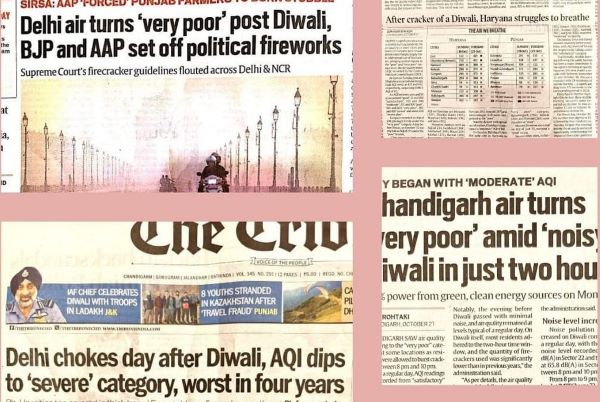 The morning after Diwali, Delhi once again woke up in a gas chamber. The sky was grey, the air poisonous, and the fingers, as always, pointed west — towards Punjab. But this year, the truth is too visible, and too inconvenient: Delhi is choking on its own smoke, not Punjab’s.
The morning after Diwali, Delhi once again woke up in a gas chamber. The sky was grey, the air poisonous, and the fingers, as always, pointed west — towards Punjab. But this year, the truth is too visible, and too inconvenient: Delhi is choking on its own smoke, not Punjab’s.
All three major newspapers — The Indian Express, The Tribune and Hindustan Times — told the same story with minor variations. Delhi’s air turned “severe”, the worst in four years, as fireworks smothered the Capital in thick haze. The Hindustan Times measured PM2.5 levels at 785.6 µg/m³, thirty times the safe limit. At Anand Vihar and Nehru Nagar, it spiked to an astonishing 1,710 and 1,763 µg/m³. The Indian Express recorded Delhi’s average AQI at 351 (“very poor”), while The Tribune pegged it at 421 (“severe”) — the worst post-Diwali reading since 2021.
Let that sink in. These are not the numbers of a city suffocating on “Punjab’s smoke.” These are the numbers of a city that set itself on fire, every year, in the name of celebration.
Meanwhile, Hindustan Times (Punjab edition) reported that Ludhiana — Punjab’s most industrialized city — recorded an AQI of 282, followed by Mandi Gobindgarh (275), Amritsar (244), and Patiala (235). The state’s average AQI stood at 236, actually better than last year’s 285, despite post-Diwali haze. This year, farm fires in Punjab are down 72%, thanks to delayed paddy harvesting after the late monsoon. Only 415 cases were reported till October 20 — compared to 1,510 last year and 1,764 in 2023.
So, the numbers demolish the narrative. But there’s more: the winds themselves tell the story.
Satellite data from Zoom Earth between October 20–22 show the air currents over Delhi blowing east to west — from Uttar Pradesh into Delhi, not the other way round. Winds over Punjab, meanwhile, were moving westward toward Rajasthan and Pakistan. The smoke from Punjab simply could not have reached Delhi. https://zoom.earth/
Yet Delhi’s politicians find Punjab a convenient villain — easy to accuse, far to verify.
The Indian Express reported how Delhi BJP leader Manjinder Singh Sirsa claimed that AAP “forced Punjab’s farmers to burn stubble to pollute the capital.” The allegation is absurd on its face — Punjab’s farm fires have dropped drastically, and wind directions contradict the claim entirely. It’s not science; it’s politics.

Is former Member of Punjab Public Service Commission
A farmer and keen observer of current affairs
Earlier the AAP government in Punjab used to blame the Congress government in Punjab for farm fire based pollution in Delhi. Punjab has become a punching bag for all governments ruling Delhi.
Blaming Punjab keeps Delhi’s citizens from asking harder questions: why are Supreme Court firecracker bans flouted every year? Why does Delhi’s governance collapse at festival time? Why must faith be celebrated through poison? Aren’t there sane ways to celebrate faith?
The farce extends beyond Delhi. Chandigarh, too saw its AQI crash from moderate to very poor within two hours of Diwali night — despite being nearer by 250 km to the Punjab farm fire than Delhi. That one fact tears apart the myth more effectively than any press conference ever could.
The Hindustan Times editorial titled “Bursting the Green Myth” put it bluntly: even so-called “green crackers” are neither green nor less toxic. They spew the same poison with a new label. By midnight, Delhi and NCR had celebrated their most firecracker-heavy Diwali in years. Rules were mocked, bans ignored, and public health traded for a night of noise and smoke. The morning’s cough was predictable.
Delhi’s real enemies are not farmers in Bathinda or Mansa. They are firecrackers, exhaust pipes, governance failure and political cowardice. Construction dust, vehicular emissions, and stagnant post-Diwali air have turned the National Capital Region into a lung hospital. The tragedy is that every year, the same ritual repeats: Delhi burns, blames Punjab, and forgets by Christmas.
Of course, Punjab’s stubble fires are an environmental concern. Farm residue should not be burnt at all. I had written a piece few days back on this https://substack.com/@gpsmann/note/p-173912223?r=3598n2&utm_source=notes-share-action&utm_medium=web
But to scapegoat Punjab for Delhi’s annual gas chamber is both dishonest and unscientific. This year, when farm fires are down, winds are eastward, and data is crystal clear, the narrative of Punjab polluting Delhi collapses completely.
Delhi’s crisis is self-inflicted — the result of urban indulgence disguised as tradition, governance failure and political cowardice disguised as helplessness.
Every Diwali, Delhi celebrates with fire — and then gasps for breath. The irony could not be more bitter.
Delhi doesn’t need another scapegoat.
It needs a mirror.